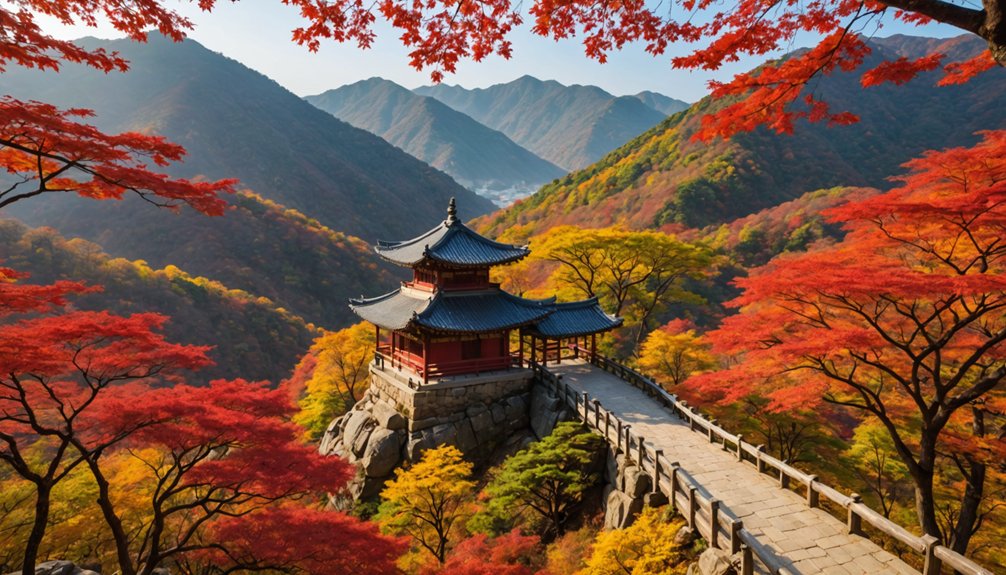The best time to visit South Korea is during spring (March to May) or autumn (September to November) when you’ll experience mild temperatures and stunning natural displays. Spring offers cherry blossoms and cultural festivals, while autumn dazzles with vibrant foliage and harvest celebrations. You’ll find fewer crowds and better hotel rates compared to peak summer months, plus comfortable conditions for exploring both cities and mountains. Understanding seasonal patterns will help you maximize your Korean adventure.
Explore East Asia
Find the perfect time to visit these travel hotspots
Key Takeaways
- Spring (March-May) offers mild temperatures and stunning cherry blossoms, making it the most popular season for international visitors.
- Fall (September-November) provides comfortable temperatures and colorful autumn foliage, with fewer crowds than spring.
- Avoid July-August due to intense heat, humidity, and monsoon rains that can disrupt travel plans.
- Winter (December-February) suits budget travelers and winter sports enthusiasts, with lower rates except during holiday periods.
- Skip major holidays like Seollal and Chuseok when transportation systems are overwhelmed and accommodation prices spike.
Weather Patterns Across South Korean Seasons
While many countries experience seasonal changes, South Korea’s weather patterns are distinctly dramatic, shaped by its position between continental Asia and the Pacific Ocean. You’ll encounter four sharply defined seasons, each bringing unique weather related travel challenges to ponder.
Winter grips the peninsula with Siberian winds, dropping temperatures below freezing, while summer releases intense heat and humidity alongside the monsoon’s drenching rains. Spring emerges with swift warming, though you’ll need to watch for yellow dust storms that can affect air quality, particularly in March and April. Regional variations are notable, with typhoons affecting southern areas more frequently than northern regions. Autumn offers relief with stable temperatures and clear skies, making it ideal for outdoor exploration.
Seasonal rainfall patterns concentrate heavily in the summer months, with nearly 60% of precipitation falling during the June-July monsoon season. The remaining seasons stay relatively dry, though winter’s northern regions see frequent snowfall, while coastal areas remain mostly snow-free.
Peak Tourist Seasons and When to Avoid Crowds
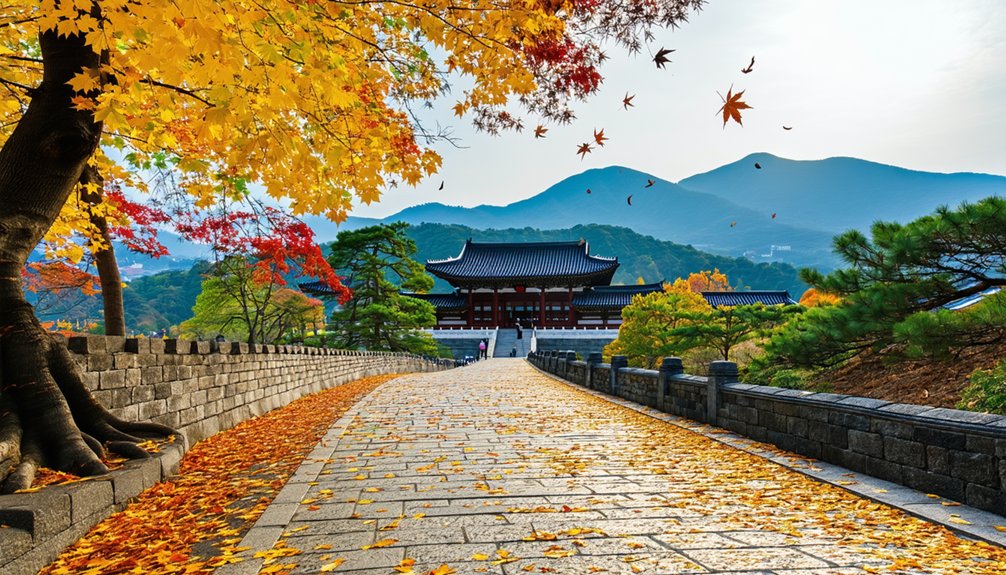
South Korea’s prime tourist seasons align with its most photogenic natural displays – cherry blossoms in spring (March-May) and vibrant foliage in autumn (September-November), when you’ll encounter peak hotel rates and lengthy attraction queues. While summer brings fewer international visitors, you’ll still face substantial crowds as domestic travelers flock to beaches and festivals, particularly during August school breaks. If you’re seeking relatively quieter periods, consider visiting in winter months (December-February) when foreign tourism dips, though you’ll share popular ski resorts with enthusiastic local winter sports fans. It’s especially important to avoid traveling during Korean New Year when transportation and accommodations become overwhelmingly crowded.
High-Season Tourist Patterns
The peak tourist seasons in South Korea follow a predictable rhythm, with spring and autumn emerging as the most crowded periods. Regional tourism trends show intense visitor concentrations during cherry blossom season in March-April and autumn foliage in October, driving seasonal pricing fluctuations up by 20-30%.
You’ll encounter the heaviest crowds during these key periods:
- Spring (March-May): Cherry blossoms draw international tourists, with festivals like Jinhae Gunhangje creating accommodation shortages
- Autumn (September-November): Fall colors and events like the Busan Film Festival attract both domestic and international visitors
- Summer (July-August): Domestic tourism peaks at beaches and festivals, though monsoon rains can impact travel
Major holidays like Chuseok and Lunar New Year also trigger significant domestic travel surges, making advance planning essential for these periods. Winter tourism dips significantly as freezing temperatures in December through February discourage many visitors from exploring the country.
Quieter Travel Periods
Planning a visit during South Korea’s quieter periods can reward you with peaceful exploration and better deals. You’ll find prime opportunities to explore remote destinations during late November and the winter months of January-February, when temperatures drop below freezing but crowds thin drastically. The Gangwon-do Province typically experiences the heaviest snowfall, making it a serene winter destination.
| Season | Best Quiet Times | Temperature | Key Benefits |
|---|---|---|---|
| Winter | Dec – Feb | -5°C to 5°C | Empty cities |
| Spring | Early March | 10-15°C | Pre-cherry blossom calm |
| Summer | Mid-June | 20-25°C | Pre-monsoon peace |
| Fall | Late Sept | 20-24°C | Post-tourist serenity |
Off season advantages include reduced rates at accommodations and fewer tourists at popular sites. Consider visiting during shoulder seasons like early March or late September when you’ll enjoy mild weather while avoiding peak crowds at temples and cultural sites.
Region-by-Region Climate Guide
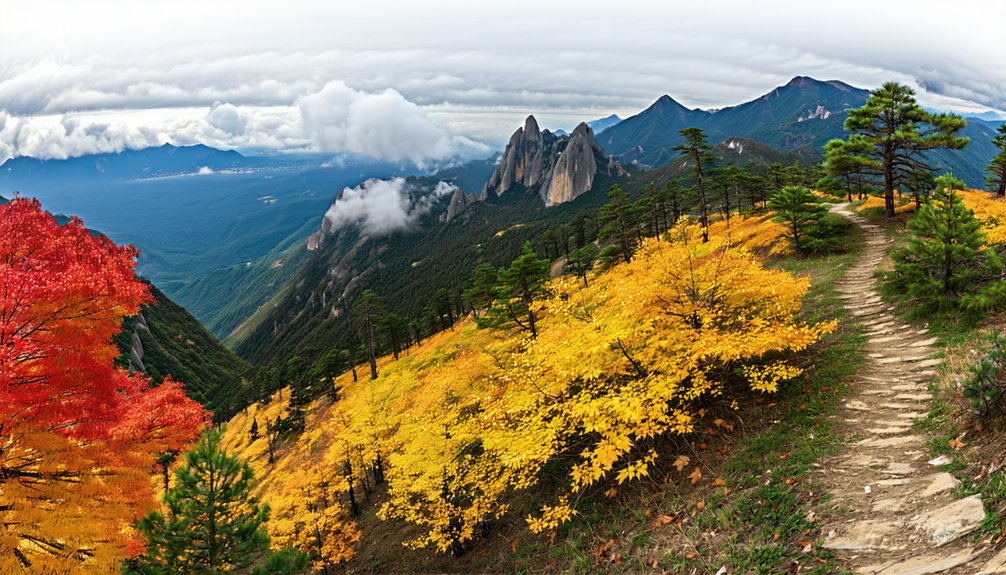
Understanding Korea’s regional climate patterns helps you plan the perfect visit to this diverse peninsula. Regional climate variations require strategic seasonal packing recommendations as you explore different areas of the country.
- Northern regions like Seoul experience dramatic seasonal swings, from frigid -20°C winters to sweltering summer days above 30°C with high humidity. You’ll need both heavy winter gear and lightweight summer clothing. The area’s proximity to Asia means continental weather patterns strongly influence temperatures.
- The central region offers more moderate conditions, with Daejeon’s comfortable spring and fall temperatures making it ideal for outdoor activities. Pack layers during these shoulder seasons.
- Southern coastal areas like Busan enjoy milder winters but face intense summer heat and typhoon risks. Bring rain gear if visiting July through September.
The eastern coast presents unique conditions due to the Taebaek Mountains, with Gangneung receiving significant sea-effect snow in winter while enjoying pleasant summer temperatures moderated by ocean breezes. Consider these distinct microclimates when planning your Korean adventure.
Cultural Festivals and Holiday Impact on Travel
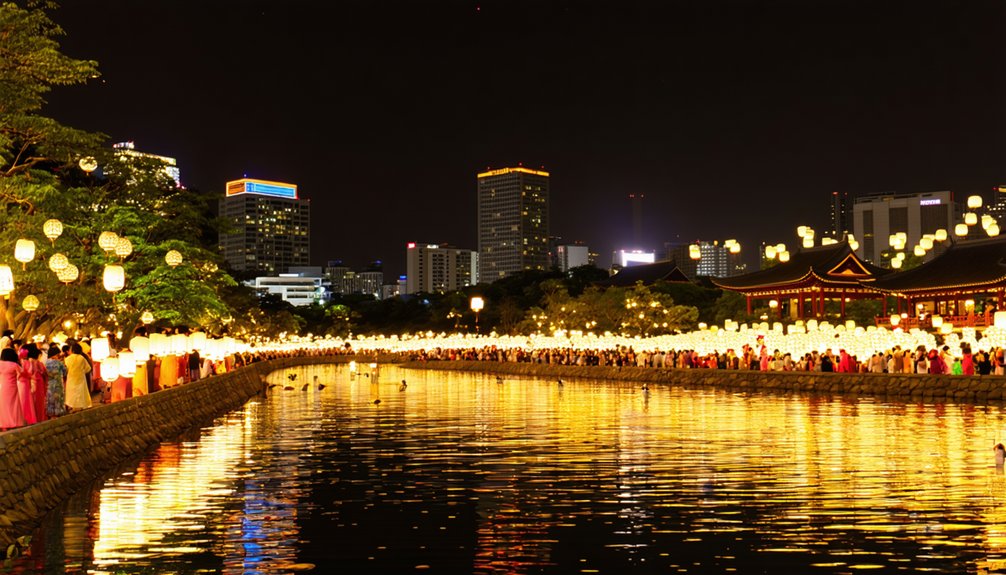
When mapping out your Korean adventure, you’ll need to carefully weave around the country’s vibrant festival calendar and major holidays. Seollal and Chuseok create nationwide travel surges, with accommodations booking up months in advance and transportation networks stretching to their limits. Many festivities follow both solar and lunar calendars, creating a dynamic year-round cultural experience.
| Festival | Impact on Travel |
|---|---|
| Seollal | Massive exodus from cities; 3-day business closures |
| Chuseok | Peak domestic travel; traditional markets bustling |
| Buddha’s Birthday | Temple stays fill up; lantern-lit cities |
| Dano Festival | Unique local festival experiences in Gangneung |
| Hansik | Quieter travel period; cuisine and culinary traditions spotlight |
For authentic cultural immersion, time your visit around Buddha’s Birthday in May, when temples nationwide open their doors for unique ceremonies. Alternatively, target regional festivals like Gwangyang’s Maehwa Festival in March or Boseong’s Green Tea Festival in May, where you’ll encounter fewer tourists and more genuine local experiences. Just remember to book accommodations well ahead, especially during peak celebration periods.
Outdoor Activities and Seasonal Highlights
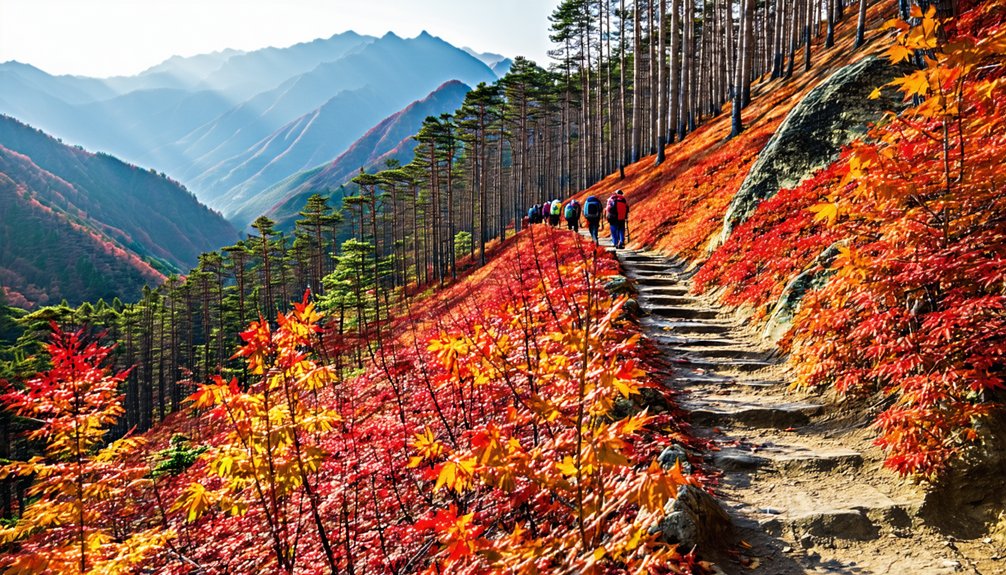
South Korea’s outdoor activities align perfectly with its distinct seasons, offering you peak experiences from spring cherry blossom hikes to winter skiing in Pyeongchang. You’ll find mountain adventures accessible year-round, though you’ll need to adjust your gear from lightweight hiking equipment in autumn’s comfortable temperatures to crampons for winter’s frozen waterfalls in Odaesan. The coastal calendar shifts from summer swimming at Haeundae Beach to spectacular autumn photography along the East Coast’s Homigot Cape, with each season presenting its own unique outdoor opportunities. During late summer, visitors should prepare for the monsoon season conditions when planning outdoor excursions, particularly in July and August.
Peak Season Activities
Throughout South Korea’s peak seasons, you’ll discover a vibrant tapestry of outdoor activities and cultural celebrations that showcase the country’s natural beauty and rich traditions. From the stunning cherry blossoms in spring to illuminated night festivals in autumn, each season offers unique experiences.
The most mesmerizing seasonal activities include:
- Strolling beneath 350,000 cherry trees at Jinhae Festival while sampling street food and enjoying nighttime illuminations
- Witnessing the spectacular Lotus Lantern Festival with 100,000+ lanterns lighting up Seoul’s streets
- Exploring the fiery autumn foliage at Seoraksan via cable car, or walking the golden ginkgo-lined Songjeong path
These diverse cultural events perfectly blend nature’s beauty with traditional customs, letting you experience Korea’s dynamic seasonal shifts in the most authentic way. The spring season brings visitors to Yeouido Spring Flower Festival, where cherry blossom-lined streets create picture-perfect moments against Seoul’s modern skyline.
Mountain Adventures Year-Round
Korea’s majestic mountains offer a year-round playground for outdoor enthusiasts, with each season painting the peaks in distinctly beautiful hues. You’ll discover unique seasonal perks whether you’re photographing cherry blossoms in Hallasan during spring or conquering snow-covered slopes at Seoraksan in winter.
Consider the off peak pros of visiting during shoulder seasons: spring treks offer mild temperatures and fewer crowds, while autumn rewards you with spectacular foliage and crystal-clear visibility for photography. Summer’s heat is best tackled in shaded valley trails, particularly in Bukhansan near Seoul. Winter transforms the landscape into a pristine wonderland, with northern peaks like Taebaeksan offering excellent skiing opportunities. For year-round accessibility, Apsan Mountain’s cable car delivers panoramic views regardless of when you visit. At High 1 Resort in Gangwon Province, visitors can enjoy scenic mountain trekking and gondola rides during the warmer months.
Coastal Recreation Calendar
From crystal-clear spring waters to winter’s solitary shores, the coastal regions of this peninsular nation offer distinct seasonal treasures for outdoor enthusiasts. You’ll discover off the beaten path island getaways like Udo, where autumn brings bountiful seafood harvests, while luxury resort openings along Busan’s coastline provide year-round indulgence.
Spring delivers prime cherry blossom viewing and ideal hiking conditions along Jeju’s coastal trails, with temperatures perfect for outdoor exploration. Popular activities include jet skiing and kayaking at stunning locations like Hyeopjae Beach.
Summer transforms beaches into adventure playgrounds – from surfing at Yangyang to parasailing over Jeju’s dramatic shoreline.
Fall offers the best scuba diving conditions around Jeju’s coral reefs, plus stunning coastal walks beneath golden ginkgo trees with fewer tourists to share the views.
Packing Essentials for Different Seasons
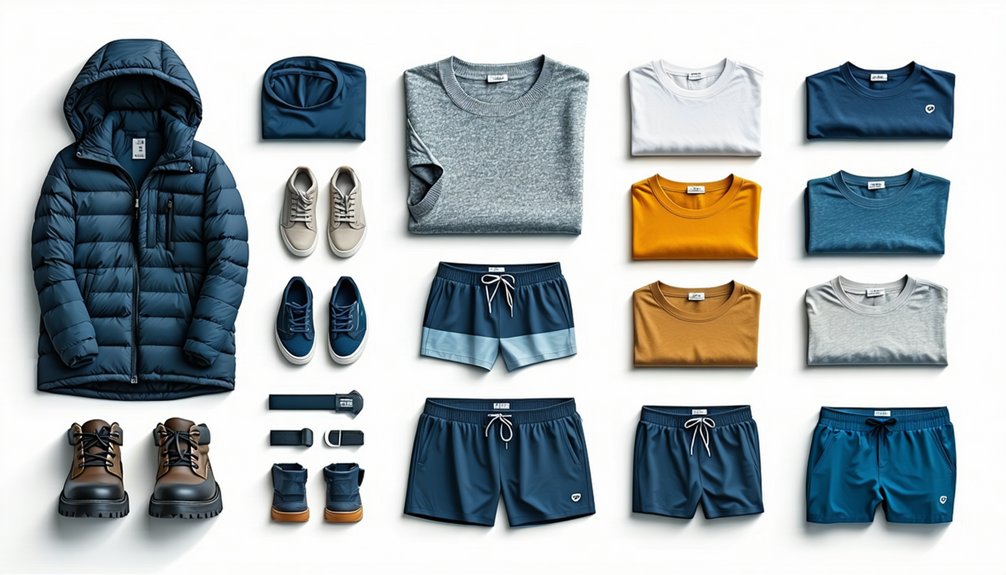
When planning your South Korean adventure, packing the right essentials can make or break your trip as the country experiences four distinct seasons with dramatic temperature swings. Summer demands lightweight cotton clothing and portable cooling solutions, while budget-conscious travelers should consider luggage storage options during monsoon season to protect belongings from intense downpours. Ensure you have a power bank for uninterrupted device usage during long days of exploration.
Winter requires serious cold-weather gear – invest in a quality down jacket and thermal base layers for sub-zero temperatures. You’ll appreciate waterproof boots when traversing icy sidewalks, especially if you’re exploring multiple cities.
Spring and autumn offer the most packing flexibility, but smart layering is key. Pack convertible pieces and neutral separates to maximize your wardrobe while minimizing luggage. Don’t forget year-round essentials like high-SPF sunscreen and shower shoes for guesthouses. Consider seasonal budget considerations when timing your visit, as specialized gear for extreme temperatures can impact your overall travel costs.
Transportation and Accommodation Planning Tips
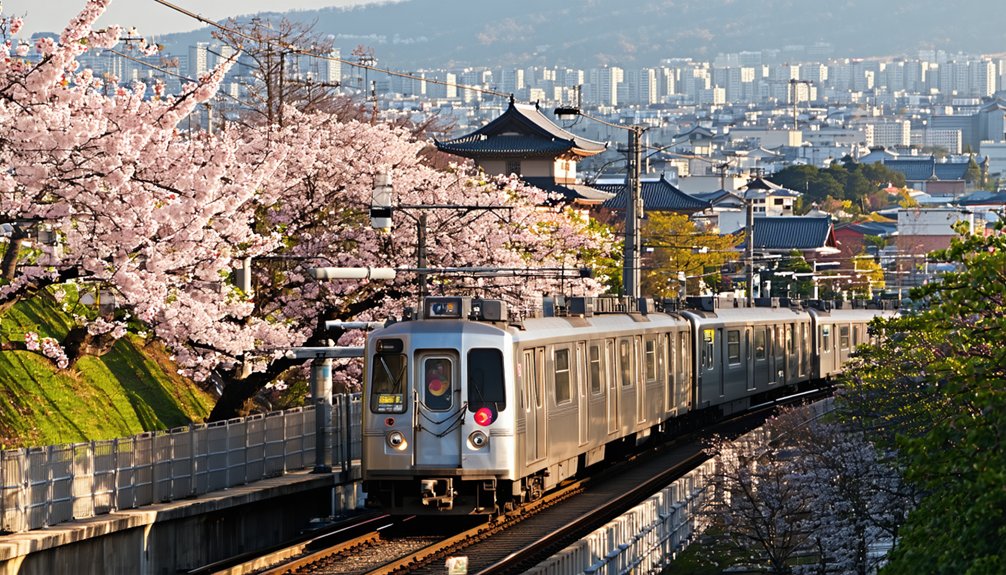
Traversing South Korea’s efficient transportation network and diverse accommodation options requires strategic planning to maximize both comfort and value. Transportation card benefits make exploring cities seamless – grab a Tmoney or NAMANE card for discounted fares and free transfers between buses and subways within 30 minutes. Kakao Map provides reliable navigation since Google Maps has limited functionality in Korea.
For budget accommodation options, you’ll find an array of choices that blend practicality with cultural immersion:
- Jimjilbangs offer 24/7 access to traditional Korean bathhouses with sleeping areas for around ₩10,000 per night
- Hanok stays immerse you in historic architecture with ondol floor heating
- Temple stays provide a unique glimpse into Buddhist living at reasonable rates
Time your visit strategically – spring and autumn offer ideal weather for exploring, but require advance bookings. Winter travelers can score lower accommodation rates, while summer visitors should prioritize lodging near subway lines to beat the humidity. Save on transportation by booking KTX trains months ahead for significant discounts.

